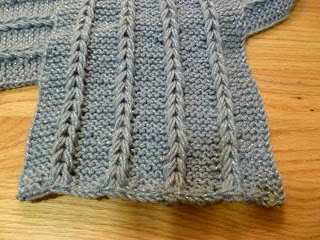Since there are only 2 more days left in 2015, I think I'm safe in saying that this will be the last knitted item that actually gets finished this year. (I have several that I've finished the knitting part, but still need to do the sewing part...the part I always put off as long as I can.)
A friend of mine gave me her stash of yarn and other knitting stuff saying, "I realize I'll never be a knitter." Given her age (mid-to-late 70s) and all the other things going on in her life, I think she's right, and I salute her for accepting reality (unlike some of us who believe we'll live long enough to take up every craft that's ever interested us).
I felt that although she would never own anything she had personally knitted, she still deserved to have something from her effort to take up knitting. Looking through her donated stash, I found 3 skeins of wool that seemed sufficient to make a scarf. The yarn, Emu Naturally Double Knit, is a discontinued 100% wool yarn from England in a heathery oatmeal color. The yarn has a rather rough texture (or maybe I'm just being overly sensitive) so I hope hand washing will soften the fibers.
The pattern I used was "Diagonal Ribbing" from Barbara G. Walker's Learn-to-Knit Afghan Book (Charles Scribner's Sons, 1974, pp. 45-46). It's a 16-row repeat pattern that works up quickly as it is primarily combinations of pairs of knit stitches and pairs of purl stitches and is completely reversable. I made it about two and half yards long, using up all but a few inches of the 3 skeins. (Interestingly, it is not the same pattern as one with the same name in Walker's A Treasury of Knitting Patterns.)
All that's left to do is sew in the tails and give the scarf a washing and blocking. Hope she enjoys using it when our weather finally turns cold.













































